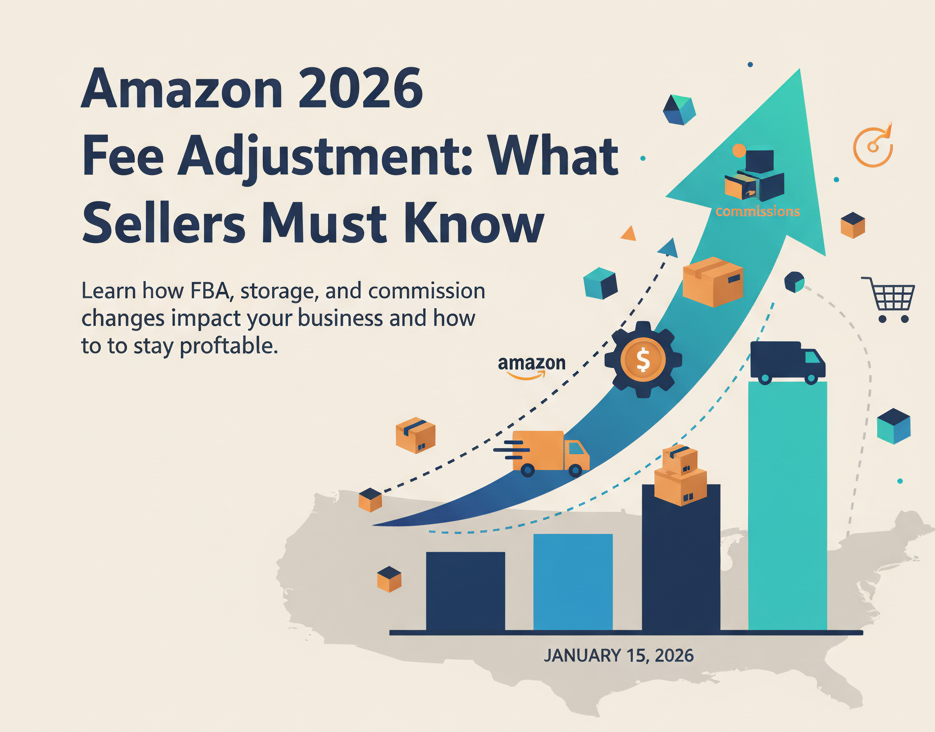Address
304 North Cardinal St.
Dorchester Center, MA 02124
Work Hours
Monday to Friday: 7AM - 7PM
Weekend: 10AM - 5PM

The Amazon 2026 fee adjustment has been officially announced, signaling another critical shift for U.S.-based Amazon sellers. While the average increase is a modest $0.08 per unit, the real impact comes from the introduction of complex new fee structures, storage surcharges, and incentive programs.
These updates will directly influence your profitability and operational planning for the year ahead.
This detailed guide breaks down the key changes effective January 15, 2026, explains how they affect your margins, and provides actionable strategies to maintain your competitive edge in the evolving FBA landscape.
Amazon emphasizes that the overall fee increase remains moderate, falling below the 3.9%–5.9% annual cost growth reported by major U.S. carriers.
The adjustment’s core purpose is to better align pricing with actual fulfillment costs, rewarding sellers for efficiency while moderating costs where Amazon’s internal logistics have improved.
Amazon is introducing fine-tuned pricing tiers for standard-size products, ensuring fees are more granularly aligned with the product’s value and size.
| Product Size & Price Range | Average Change | Strategic Impact |
| Small Standard Size ($10–$50) | +$0.25 per unit | Highest increase—optimize packaging to move below the $10 bracket if possible. |
| Large Standard Size ($10–$50) | +$0.05 per unit | Moderate increase, less impactful than small standard. |
| Items under $10 (Small/Large) | +$0.12 (Small); Unchanged (Large) | Low-price FBA discount is enhanced (+$0.09), helping competitiveness. |
| Items above $50 | +$0.51 (Small); +$0.31(Large) | Factor this significant cost into your premium product pricing. |
Amazon is tightening its inventory requirements, shifting the focus to per-variation stock health:
These changes emphasize compliance and consolidation in the logistics network:
Amazon is refining the structure for oversized goods:
Sellers utilizing Amazon Warehousing & Distribution (AWD) and Multi-Channel Fulfillment (MCF) will see several adjustments:
| Program/Region | Change | Incentive |
| AWD Storage (West Region) | Increase to $\mathbf{\$0.57}$ per cubic foot/month | East/South regions remain at $\mathbf{\$0.48}$ |
| AWD Transportation Fees | Increase to $\mathbf{\$1.40}$ per cubic foot | |
| Smart Storage Users | 10% Discount on Storage Costs | Encourages automated inventory movement. |
| MCF Fees (1–2 item orders) | Average increase of $\mathbf{\$0.30}$per unit | Orders with 3+ items are unchanged. |
Modest fee changes can quickly erode margins for high-volume sellers. Implement these strategies now to safeguard your profitability:
Amazon’s latest fee structure signals a clear move toward operational precision. Flat-rate increases are out; tailored fees that reward efficiency and healthy inventory practices are in.
For sellers, future success on Amazon will heavily depend on:
Sellers who proactively adapt will not only offset the new costs but also establish a stronger, more efficient competitive position heading into 2026.
Need expert guidance to navigate the new Amazon 2026 fee structure?
Our Amazon FBA specialists can help you optimize operations, reduce costs, and protect your profit margins. Contact us today to build a smarter, more profitable Amazon strategy for 2026 and beyond.